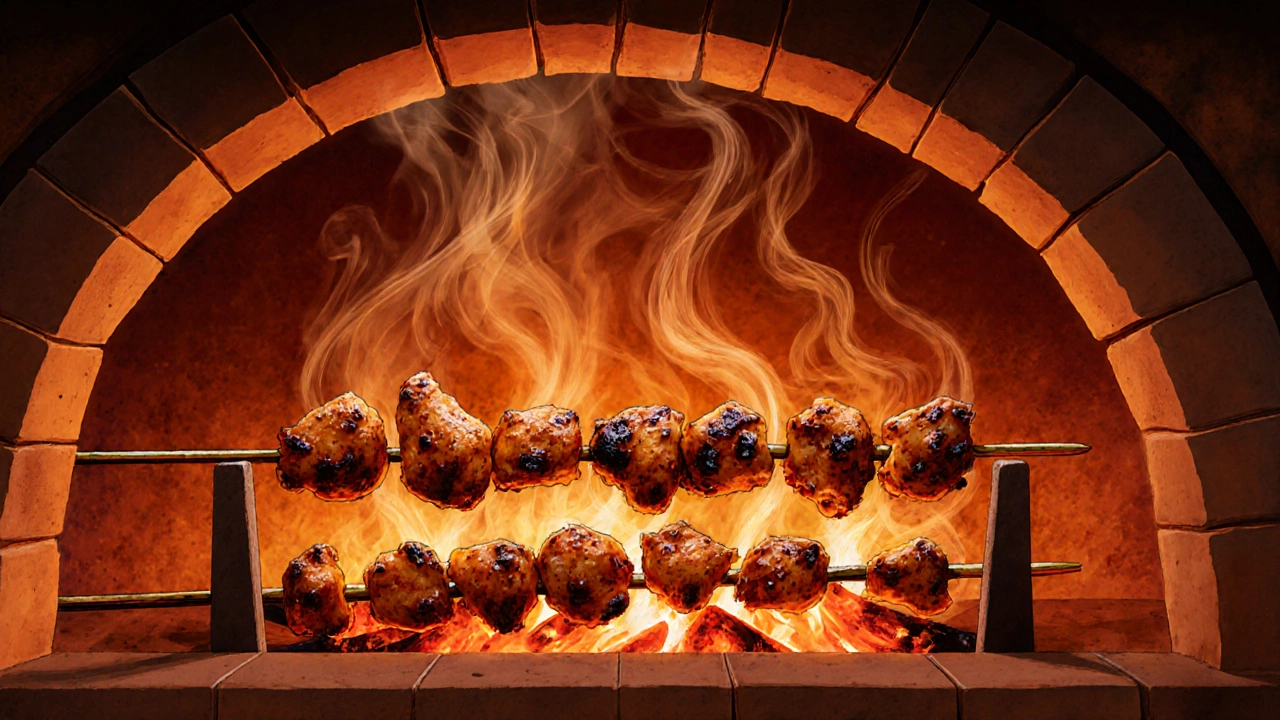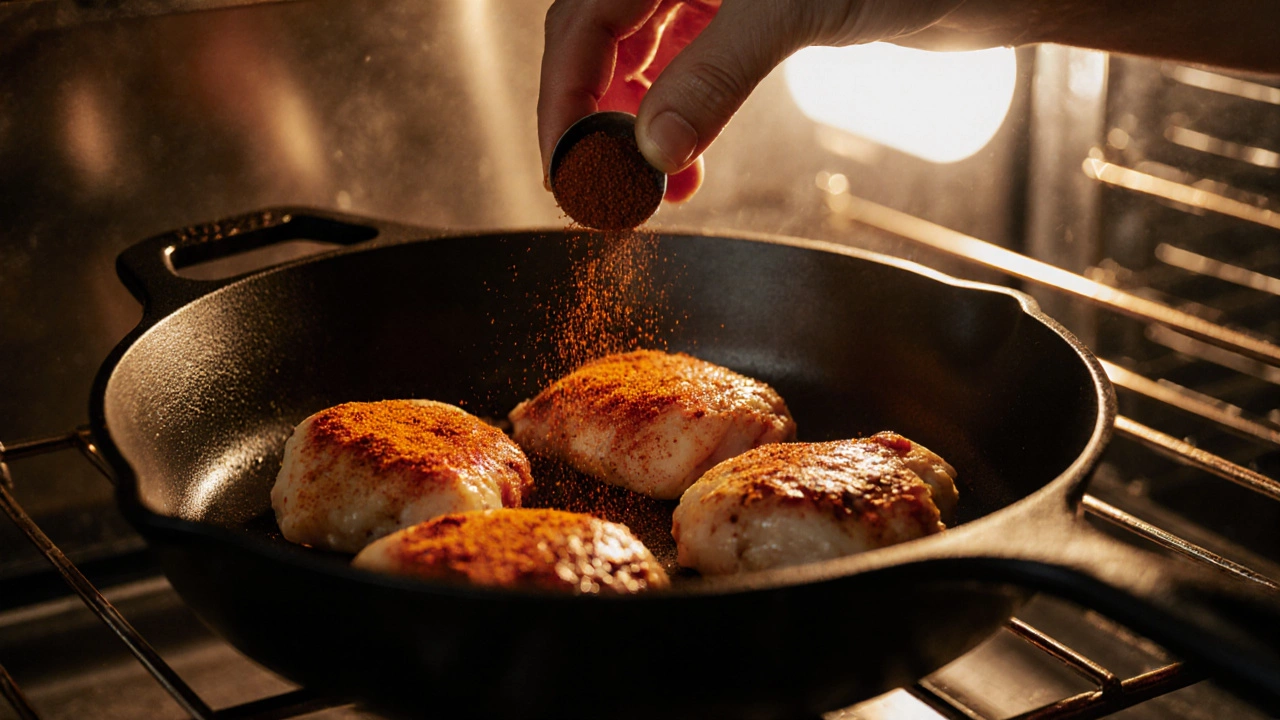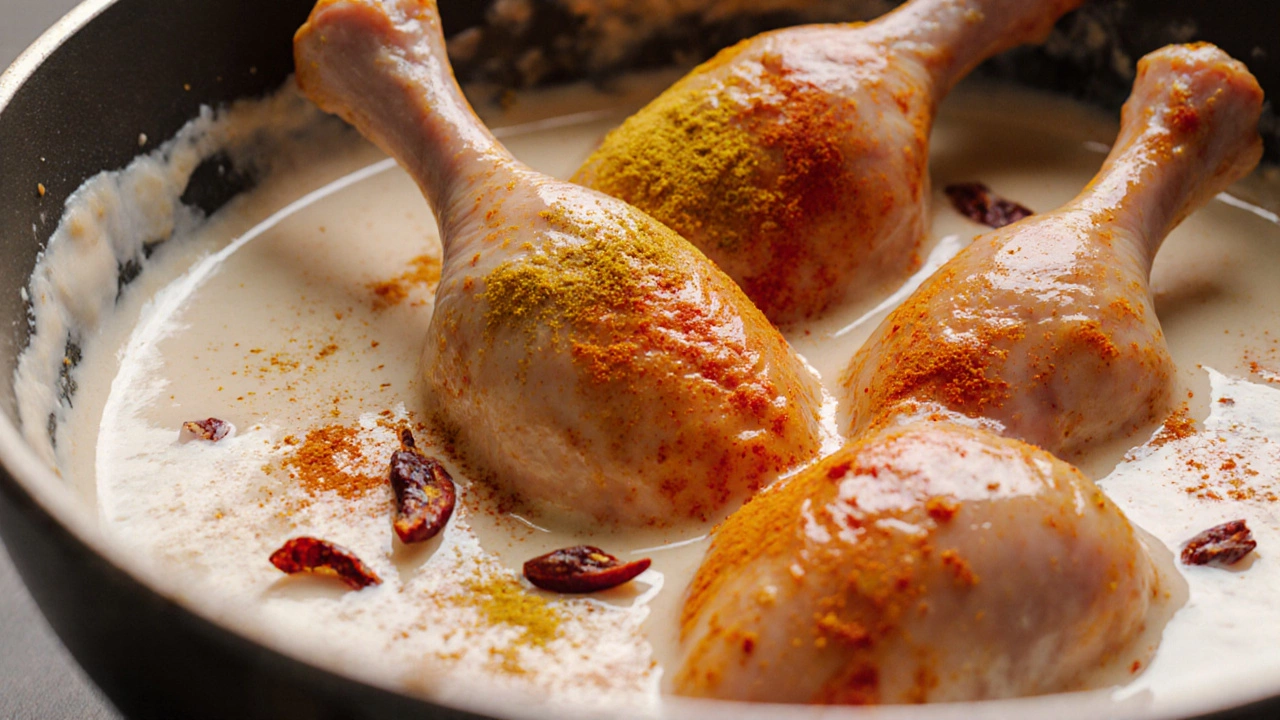Tandoori Spice Ratio Calculator
Spice Ratio Calculator
Calculate the perfect spice proportions for authentic tandoori chicken. The ideal ratio is 2 parts paprika, 1/2 part turmeric, and 1/2 part chili powder.
Your Perfect Tandoori Spice Mix
Orange Color Preview:
| Spice | Amount | Color Impact |
|---|---|---|
| Paprika | Brings the signature bright orange hue | |
| Turmeric | Creates golden undertones | |
| Red Chili Powder | Deepens the orange with rich reds |
Based on the scientific ratio: 2 parts paprika, 1/2 part turmeric, 1/2 part chili powder
Ever wonder why that classic Indian favorite looks like a piece of sunrise on a plate? The vivid orange hue of tandoori chicken isn’t just eye‑candy - it’s the result of a precise mix of spices, dairy, and heat.
Tandoori Chicken is a marinated poultry dish cooked in a traditional clay oven called a tandoor, which gives it a smoky flavor and a bright orange exterior.The Science Behind the Sunset Hue
When you dip chicken pieces into a yogurt‑spice blend, you’re starting a series of chemical reactions. Yogurt’s acidity tenderizes the meat, opening up muscle fibers so they can absorb pigments more readily. As the chicken bakes at temperatures above 400 °F (200 °C), the pigments lock in, and the Maillard reaction creates a deeper, richer color.
Key Spice That Gives the Orange Tint
While many spices contribute flavor, Paprika is the primary source of that unmistakable orange tone. Paprika is ground from sweet red peppers that contain carotenoid pigments - mainly capsanthin and beta‑carotene - which appear orange when cooked.
How Marinade Chemistry Affects Color
Besides paprika, three other ingredients play a supporting role:
- Turmeric adds a golden undertone thanks to curcumin, a bright yellow pigment that blends with paprika’s reds.
- Red Chili Powder contributes deeper reds and a punch of heat, reinforcing the orange when mixed with paprika.
- Yogurt not only tenderizes but also carries the pigments uniformly across the meat.
The balance matters. Too much turmeric turns the sauce yellow; too little paprika leaves the chicken pale. A classic ratio - 2 parts paprika, ½ part turmeric, ½ part chili powder - hits the sweet spot for that restaurant‑style orange.

Cooking Methods That Lock In the Color
Traditional tandoors use charcoal or wood fire, producing intense, direct heat and a slightly smoky environment. The heat quickly sears the exterior, trapping pigments inside. If you’re using a home oven, pre‑heat to 475 °F (245 °C) and place a cast‑iron skillet on the top rack to mimic that blast of heat. Finish under the broiler for 2‑3 minutes to develop the hallmark char.
Another factor is the Tandoor Oven itself - the clay walls retain heat and radiate it evenly, preventing uneven color spots.
Common Myths About Food Coloring
Some home cooks add artificial orange food dye, assuming it’s the only way to achieve the hue. In reality, the genuine spice blend delivers a more complex, appetizing shade without the chemical aftertaste. Food‑grade dyes can also fade under high heat, leaving a washed‑out look.
Another myth claims that the orange color means the chicken is overcooked. On the contrary, a well‑marinated piece will stay juicy inside while the surface reaches that deep orange‑brown crust.

DIY Tips to Perfect the Orange Shade
- Grind whole paprika, turmeric, and dried red chilies in a spice grinder for maximum pigment freshness.
- Use full‑fat Greek yogurt; the higher fat content helps bind the pigments to the meat.
- Add a splash of lemon juice - the extra acidity brightens the carotenoids.
- Marinate for at least 6 hours, preferably overnight, to let the pigments penetrate.
- Pat the chicken dry before cooking; excess moisture can steam the exterior, dulling the color.
- Finish on high heat (broil or grill) for the final 2‑3 minutes to create that signature char.
Spice Color Comparison
| Spice | Primary Pigment | Typical Color Impact |
|---|---|---|
| Paprika | Capsanthin, Beta‑carotene | Bright orange‑red |
| Turmeric | Curcumin | Golden yellow |
| Red Chili Powder | Capsaicin (pigment minor) | Deep red, intensifies orange |
| Kasuri Methi (Dried Fenugreek) | Flavonoids | Subtle brown undertone |
FAQ
Why does paprika give such a vivid orange color?
Paprika is made from red peppers that are rich in carotenoids like capsanthin and beta‑carotene. When heated, these pigments become more stable and shift toward orange, especially when mixed with turmeric’s yellow tones.
Can I use smoked paprika instead of sweet paprika?
Yes, smoked paprika adds a subtle smoky note that mimics a tandoor’s char. It still provides the same carotenoid pigments, so the color stays orange. Just balance the amount so the smoke flavor doesn’t overpower the dish.
Is the orange color a sign of safety or doneness?
The color indicates proper marination and cooking temperature, but you should always check internal temperature. Chicken is safe at 165 °F (74 °C) regardless of its hue.
Can I achieve the same color without a tandoor?
A hot oven or grill works well. Use the highest temperature your oven allows, place the chicken close to the broiler for the last few minutes, and you’ll get a comparable orange‑brown crust.
What if I don’t have turmeric?
You can omit it, but the orange will lean more toward red. Adding a pinch of saffron or a splash of orange juice can restore some brightness without altering the flavor too much.
Understanding the chemistry behind that gorgeous orange is the first step to nailing restaurant‑quality tandoori chicken at home. Armed with the right spices, a proper marination plan, and the right heat, you’ll turn every dinner into a visual and tasty celebration.
